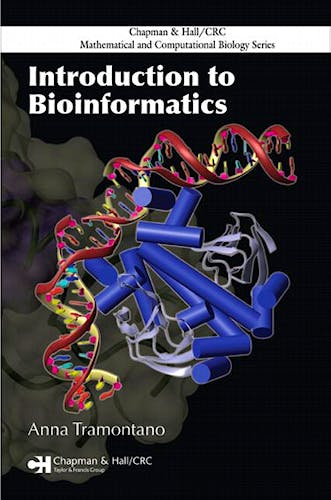

No hay productos en el carrito



Introduction to Bioinformatics
Tramontano, A.
1ª Edición Diciembre 2006
Inglés
Tapa blanda
192 pags
282 gr
16 x 24 x 1 cm
ISBN 9781584885696
Editorial CHAPMAN & HALL
LIBRO IMPRESO
-5%
97,34 €92,47 €IVA incluido
93,60 €88,91 €IVA no incluido
Recíbelo en un plazo de
2 - 3 semanas
Description
Guiding readers from the elucidation and analysis of a genomic sequence to
the prediction of a protein structure and the identification of the molecular
function, Introduction to Bioinformatics describes the rationale and limitations
of the bioinformatics methods and tools that can help solve biological problems.
Requiring only a limited mathematical and statistical background, the book shows
how to efficiently apply these approaches to biological data and evaluate the
resulting information.
The author, an expert bioinformatics researcher, first addresses the ways of
storing and retrieving the enormous amount of biological data produced every
day and the methods of decrypting the information encoded by a genome. She then
covers the tools that can detect and exploit the evolutionary and functional
relationships among biological elements. Subsequent chapters illustrate how
to predict the three-dimensional structure of a protein. The book concludes
with a discussion of the future of bioinformatics.
Even though the future will undoubtedly offer new tools for tackling problems,
most of the fundamental aspects of bioinformatics will not change. This resource
provides the essential information to understand bioinformatics methods, ultimately
facilitating in the solution of biological problems.
Features
· Emphasizes the core principles behind the methods of bioinformatics
· Discusses the limitations and range of applicability of each methodology
· Presents material on proteomics not found in other basic bioinformatics
texts
· Includes problems, references to historical and key articles, and pointers
to useful Internet sites
· Provides a solution manual with qualifying course adoptions
Table of Contents
The Data: Storage and Retrieval
Basic Principles
The Data
Data Quality
Data Representation
Genome Sequence Analysis
Basic Concepts
Genome Sequencing
Finding the Genes
Statistical Methods to Search for Genes
Comparative Genomics
A Virtual Window on Genomes: The World Wide Web
Protein Evolution
Basic Concepts
Molecular Evolution
How to Align Two Similar Sequences
Similarity Matrices
Penalties for Insertions and Deletions
The Alignment Algorithm
Multiple Alignments
Phylogenetic Trees
Similarity Searches in Databases
Basic Principles
The Methods
Amino Acid Sequence Analysis
Basic Principles
Search for Sequence Patterns
Feature Extraction
Secondary Structure: Part One
Prediction of the Three-Dimensional Structure of a Protein
Basic Principles
The CASP Experiment
Secondary Structure Prediction: Part Two
Long-Range Contact Prediction
Predicting Molecular Complexes: Docking Methods
Homology Modeling
Basic Principles
The Steps of Comparative Modeling
Accuracy of Homology Models
Manual versus Automatic Models
Practical Notes
Summing Up
Fold Recognition Methods
Basic Principles
Profile-Based Methods
Threading Methods
The Fold Library
How Well Do These Methods Work?
New Fold Modeling
Basic Principles
Estimating the Energy of a Protein Conformation
Energy Minimization
Molecular Dynamics
The “Omics” Universe
Basic Principles
Transcriptomics
Proteomics
Interactomics
Structural Genomics
Pharmacogenomics
But This Is Not All
Useful Web Sites
Index
A Glossary, References, and Problems appear in each chapter.
Reviews
Editorial Reviews
“… Overall, the book is well organized and clearly written. This
book is a good mixture of theory and practical applications. … graduate
and research students of biostatistics who want to pursue a career in experimental
biology will enjoy this book. In addition, practitioners in cancer research
and forensic science will find this book quite useful. I also recommend it for
library purchase.”
—Kuldeep Kumar (Bond University), Journal of the Royal Statistical Society
"…Introduction to Bioinformatics serves a noble purpose … Tramontano’s
added emphasis on proteomics should serve as an indication of a major current
focus of bioinformatics and also to welcome Introduction to Bioinformatics into
the canon of bioinformatics-related literature."
—Eric D. Foster, University of Iowa, The American Statistician, August
2008
"This book provides a nice summary of introductory topics in bioinformatics,
suitable for higher-level undergraduates with some biological background looking
to enter the field or masters-level graduate students. … the subject matter
is informative and well written for an introductory book."
—International Statistical Review, 2008
“By reading the book from cover to cover, the reader will acquire a sense
of the richness of the field of bioinformatics.”
—Jonathan Hodgson, Zentralblatt Math, Vol. 1115 (2007/17)
© 2025 Axón Librería S.L.
2.149.0